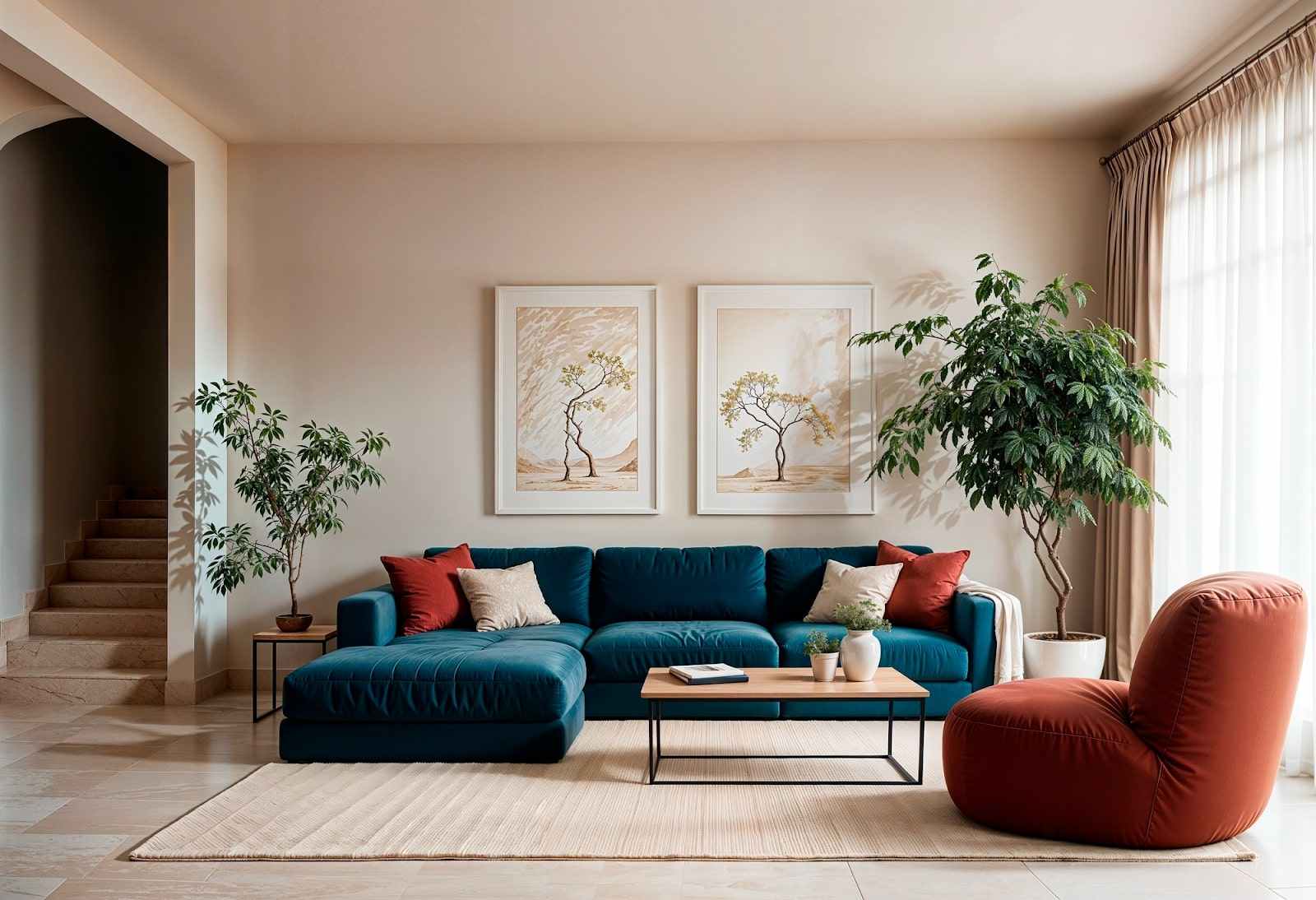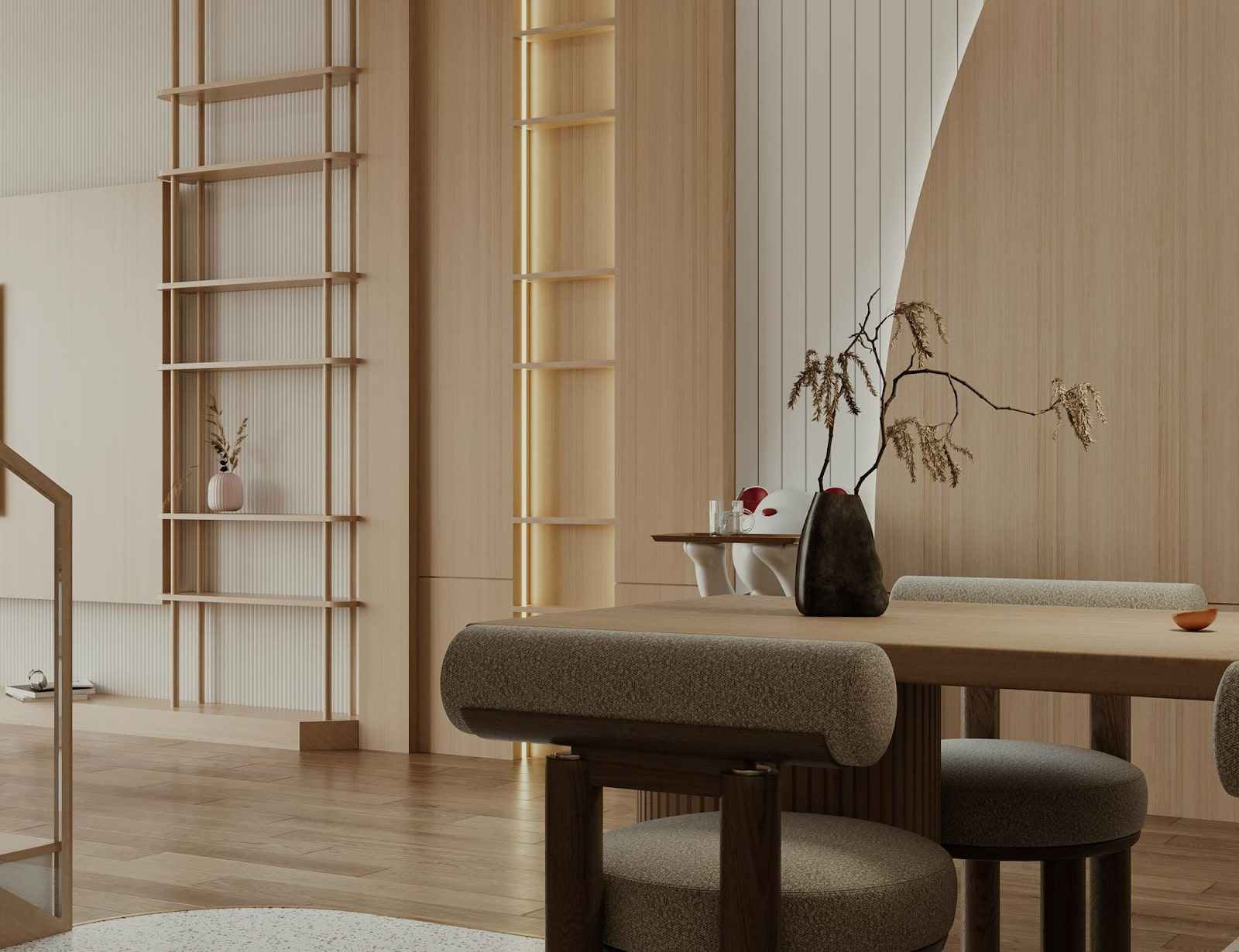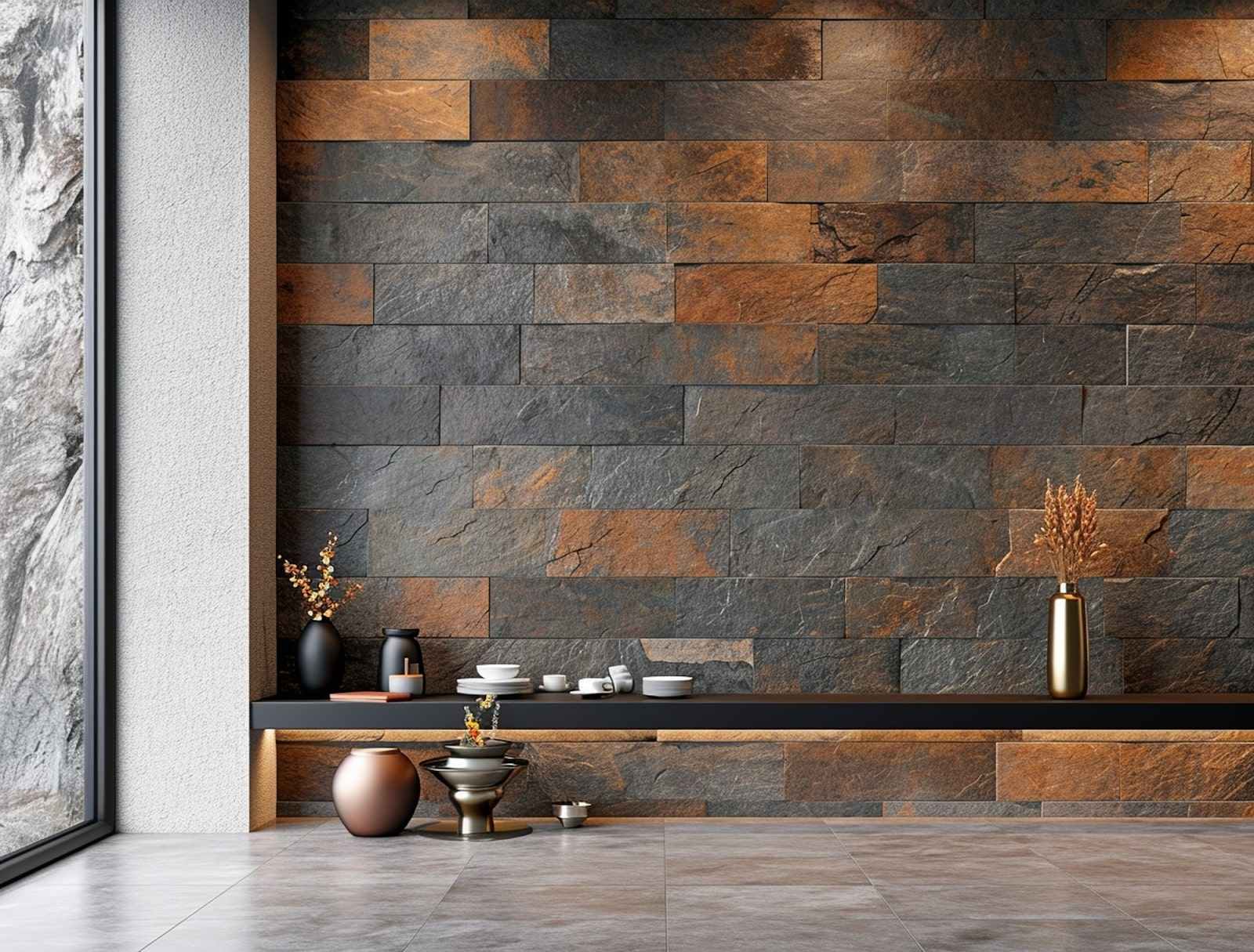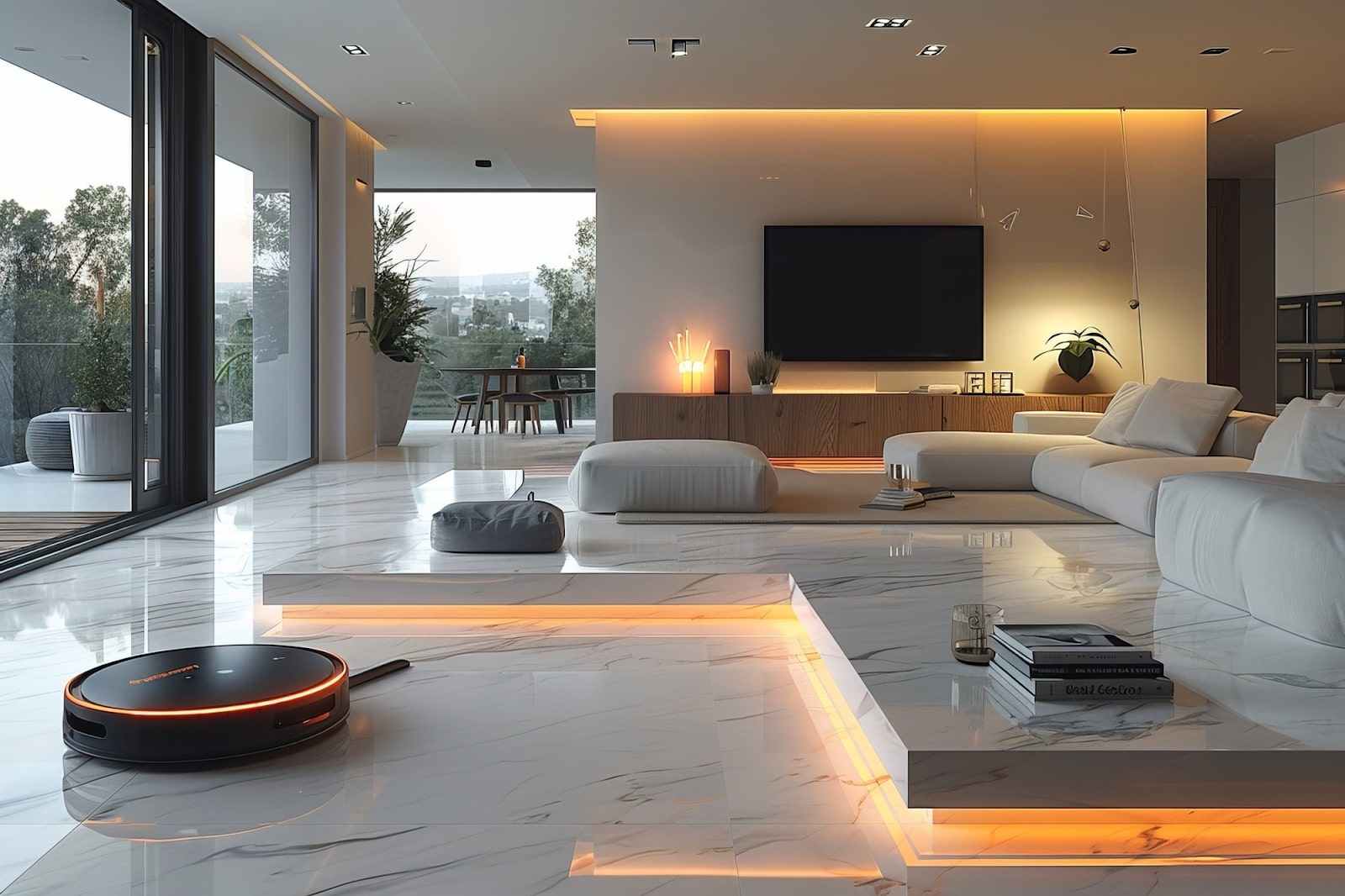
Interior design is constantly evolving, and 2025 promises some exciting shifts for modern homes. If you’ve been asking, “what are the latest trends in interior design?”, this guide will provide the answers.
From innovative technology and smart home integration to sustainability-driven choices, the trends we’re seeing now reflect how lifestyles are changing and how spaces are being used more thoughtfully.
Whether you’re updating a corporate workspace or refreshing a residential property, understanding these trends can help you create stylish, functional, and future-ready interiors. In this article, we explore 23 key trends shaping the look and feel of homes this year.
1. Japandi Revival

Japandi combines the elegance of Japanese minimalism with the warmth of Scandinavian design, creating interiors that are uncluttered, inviting, and highly functional. Clean lines, simple furniture, and neutral colour palettes form the foundation, allowing each element to serve a purpose without overwhelming the space.
Natural materials such as wood, bamboo, and linen bring texture, warmth, and durability, making them ideal for both residential and commercial environments. In Singapore’s tropical climate, selecting high-quality, treated wood or eco-friendly composites ensures longevity while maintaining the organic aesthetic.
By emphasising open layouts, hidden storage, and restrained décor, Japandi promotes calm and mental clarity, making it perfect for modern living as well as offices that need a balance of productivity and sophistication.
2. Textured Walls & Ceilings
Textured walls and ceilings are becoming a central feature in modern interiors, transforming flat surfaces into elements of depth and character. Panels, decorative plaster, and patterned wallpapers add visual interest, subtly defining spaces and enhancing the overall ambience.
Incorporating a variety of materials such as wood, stone, metal, and fabric provides a tactile experience that elevates the room: wood brings warmth, stone adds solidity, metal introduces a contemporary edge, and fabrics offer softness while improving acoustics.
By treating walls and ceilings as accent features rather than just structural components, designers can create dynamic, visually compelling spaces that complement furniture and décor.
For commercial interiors in Singapore, this approach results in professional, sophisticated environments that leave a strong impression on clients and employees alike.
3. Wellness-Focused Spaces
Wellness-focused interiors are designed to support both mental and physical well-being, making them increasingly popular in homes and commercial spaces alike. Meditation corners, yoga areas, or quiet zones create dedicated spaces for relaxation and mindfulness, helping occupants recharge and reduce stress.
Maximising natural light is another key element, with large windows, skylights, and strategically placed mirrors allowing sunlight to fill the space, which can boost mood, energy, and productivity.
Indoor plants further enhance this sense of calm by improving air quality and adding a touch of nature to interiors, creating a serene environment that promotes focus, creativity, and overall wellness.
In corporate offices, these elements can directly impact employee satisfaction and efficiency, while in residential settings they make everyday living more balanced and restorative.
4. Panel Drenching

Panel drenching is an emerging trend that transforms walls from simple backdrops into striking design features, giving spaces a cohesive and sophisticated feel.
Covering walls with matching panels—from wood to plaster or MDF—creates depth and texture, while allowing designers to experiment with subtle patterns and finishes without overcrowding the room.
Layering materials adds visual interest and tactile appeal, enhancing the overall aesthetic and creating a sense of richness and complexity. This technique also imparts a polished, high-end look without the need for excessive décor, making it ideal for commercial offices that require a professional yet stylish atmosphere.
In Singapore’s corporate spaces, panel drenching can elevate client-facing areas and work zones alike, combining practicality with an unmistakable sense of luxury.
5. Art Deco Resurgence
Art Deco is experiencing a revival, bringing bold, glamorous elements back into modern interiors. Geometric shapes and striking patterns create visual drama, transforming walls, flooring, and furniture into focal points that capture attention without overwhelming the space.
Glossy finishes, including lacquered furniture, mirrored surfaces, and polished metals, reflect light and add sophistication, elevating both residential and commercial environments.
Complementing this, rich colours like emerald, navy, and deep burgundy, paired with metallic accents such as gold or brass, infuse interiors with opulence and elegance.
This resurgence allows businesses and homeowners alike to achieve a refined aesthetic that communicates both style and confidence, making spaces feel prestigious and memorable.
6. Brown Furniture
Brown furniture continues to be a cornerstone of interior design, offering warmth, comfort, and a sense of grounded elegance. Rich wooden tones—from walnut to teak—bring a natural coziness that complements a wide range of styles, from contemporary minimalism to classic layouts.
Timeless designs ensure that these pieces remain relevant, providing versatility in both corporate offices and residential settings. By combining smooth, polished finishes with rougher, textured wood elements, designers can introduce subtle contrast and depth, enhancing visual interest and tactile appeal.
For businesses in Singapore, incorporating brown furniture can create inviting yet professional spaces that balance aesthetic charm with practical durability.
7. Verdigris Accents

Verdigris accents, with their subtle green-blue copper patina, are gaining popularity as a sophisticated design detail. These tones are often incorporated into lighting fixtures, hardware, and decorative elements, adding depth and character to interiors.
Verdigris provides vintage charm, introducing a sense of aged elegance that contrasts beautifully with modern furnishings and clean lines. When used strategically as statement pieces, such as lamps, handles, or wall art, these accents enhance a room’s personality and create focal points that catch the eye.
For commercial spaces in Singapore, verdigris elements offer a unique way to combine luxury, creativity, and understated sophistication, leaving a lasting impression on visitors and employees alike.
8. Velvet Textiles
Velvet textiles bring a sense of soft luxury to modern interiors, creating plush, inviting spaces for both residential and commercial environments. Upholstered chairs, sofas, and cushions in velvet add tactile richness, making meeting areas, lounges, or living rooms feel sophisticated yet comfortable.
Designers are exploring a wide range of colours, from rich jewel tones like emerald, sapphire, and ruby to muted neutrals such as taupe, grey, and dusty pink, allowing interiors to convey either bold personality or understated elegance.
Layering velvet with other materials—such as linen throws, wool rugs, or wooden furniture—adds depth and visual interest, ensuring that spaces feel multidimensional, balanced, and thoughtfully curated.
In Singapore’s corporate offices, these combinations can create luxurious yet approachable areas that impress clients and enhance employee comfort.
9. Sustainable Materials
Sustainable materials are a defining feature of modern interior design, reflecting a growing awareness of environmental responsibility.
Eco-friendly options like reclaimed wood, bamboo, and recycled metals not only reduce waste but also bring natural beauty and texture into interiors, whether in office desks, cabinetry, or decorative fixtures.
Durability is another advantage, as these materials are designed to withstand daily use while maintaining their aesthetic appeal, making them ideal for high-traffic commercial spaces.
Mindful design focuses on reducing environmental impact, from selecting low-VOC paints to using ethically sourced fabrics, enabling businesses and homeowners to create spaces that are stylish, functional, and responsible.
Incorporating sustainable materials in Singapore’s offices or retail spaces demonstrates a commitment to quality, innovation, and eco-conscious practices while enhancing the overall ambience and appeal of the environment.
10. Multifunctional Furniture

Multifunctional furniture is increasingly essential in both modern homes and corporate spaces, offering smart solutions that maximise efficiency without compromising style.
Items such as sofa beds, expandable dining or meeting tables, and modular shelving units allow spaces to adapt quickly to changing needs, making them ideal for small apartments or flexible office layouts.
These pieces combine practicality with aesthetics, ensuring that every item contributes to the overall design while serving multiple purposes.
For instance, a modular workstation in a Singapore office can be rearranged for collaborative projects or private work, while storage-integrated benches in a reception area keep clutter out of sight yet remain visually appealing.
By prioritising adaptability, multifunctional furniture supports productivity, comfort, and a streamlined environment in both residential and commercial interiors.
11. Bold Colour Palettes
Bold colour palettes are transforming interiors by introducing vibrancy and personality into spaces, energising occupants and creating memorable environments.
Designers are experimenting with rich hues such as deep teal, burnt orange, mustard yellow, and emerald green, using them to highlight walls, furniture, or key accessories.
Pairing these bold colours with neutral backdrops like soft greys, creams, or muted pastels allows the tones to stand out without overwhelming the space.
Statement pieces, such as a brightly upholstered chair, a coloured feature wall, or a vibrant rug, provide focal points that define a room’s character and can align with brand identity in corporate offices.
In Singapore, incorporating bold colours strategically can transform ordinary spaces into engaging, dynamic environments that inspire creativity and leave lasting impressions on clients and employees alike.
12. Maximalist Decor
Maximalist décor celebrates individuality and creativity by layering textures, patterns, and decorative elements to create vibrant, visually stimulating spaces. Mixing fabrics, rugs, cushions, and wall art adds depth and richness, transforming interiors into dynamic environments that feel lived-in and personalised.
Eclectic combinations of shapes, colours, and patterns allow designers to break conventional design rules while maintaining harmony through thoughtful curation.
This approach provides opportunities to showcase personality and brand identity, particularly in offices or commercial spaces, where unique interiors can impress clients and inspire employees.
By embracing maximalism, Singaporean homes and workplaces alike can reflect creativity, confidence, and a distinctive sense of style.
13. Natural Stone Surfaces

Natural stone surfaces continue to be a hallmark of elegance and durability in interior design, offering timeless appeal across residential and commercial settings.
Marble, granite, and limestone make for sophisticated flooring options that anchor spaces with refinement, while also being highly durable for high-traffic areas.
Stone countertops and accent surfaces, such as feature walls or tabletops, combine functionality with visual impact, providing a striking, polished look that complements other design elements.
The unique veining and patterns of each stone piece introduce texture and character, ensuring that no two installations are exactly alike. In Singapore offices and homes, natural stone elevates interiors with a sense of permanence, luxury, and understated sophistication.
14. Indoor-Outdoor Living
Indoor-outdoor living creates a seamless connection between interior spaces and the surrounding environment, enhancing both functionality and aesthetic appeal.
Sliding doors, patios, decks, and large glass panels allow spaces to flow effortlessly, making homes and offices feel more open, bright, and spacious. Integrating greenery and natural elements—such as potted plants, vertical gardens, or outdoor seating areas—further blurs the line between indoors and outdoors, bringing freshness and vitality into every room.
This design approach is particularly effective for lifestyle-focused spaces, offering opportunities for relaxation, entertaining guests, or simply enjoying a calm, rejuvenating atmosphere.
In Singapore, where outdoor areas are often limited, thoughtful planning and creative use of terraces or balconies can maximise these benefits.
15. Biophilic Design
Biophilic design prioritises bringing elements of nature indoors to create healthier, more inspiring spaces. Incorporating plants, water features, natural light, and organic materials not only adds visual beauty but also supports well-being by improving air quality, reducing stress, and boosting mood and productivity.
Textures and colours inspired by nature—such as wood grains, stone surfaces, and earthy tones—enhance aesthetic harmony while creating a sense of balance and calm.
In corporate environments, biophilic design can enhance employee satisfaction and creativity, while in homes it fosters comfort, relaxation, and connection to the natural world. Thoughtful integration ensures interiors feel vibrant, energised, and aligned with sustainable living principles.
16. Smart Home Integration

Smart home integration is transforming modern interiors by combining convenience, efficiency, and innovation. Automated lighting, climate control, and connected appliances allow homeowners and office managers to control environments seamlessly, improving comfort and productivity.
Energy-efficient technologies, such as smart thermostats, sensor-based lighting, and automated blinds, help reduce electricity consumption while maintaining optimal conditions throughout the day.
Beyond sustainability, these solutions offer modern convenience, from scheduling coffee machines in the morning to adjusting office lighting for meetings, making spaces adaptable to occupants’ needs.
In Singapore, integrating smart home systems into commercial and residential properties not only enhances functionality but also signals forward-thinking design that aligns with contemporary lifestyles.
17. Vintage And Retro Elements
Vintage and retro elements bring character and personality to contemporary interiors, creating a bridge between past and present. Mid-century furniture, classic retro accessories, and nostalgic décor pieces add timeless appeal, evoking a sense of history and familiarity.
These elements can be blended thoughtfully with modern interiors, allowing clean lines and contemporary materials to complement vintage forms and textures. For example, a retro leather armchair paired with sleek office desks or a vintage sideboard in a modern living room creates contrast and visual intrigue.
In corporate offices and homes across Singapore, vintage touches not only enrich the aesthetic but also convey sophistication, storytelling, and individuality within the space.
18. Artisanal Craftsmanship
Artisanal craftsmanship brings a unique, handmade quality to modern interiors, combining beauty, personality, and functionality. Pieces such as bespoke furniture, handwoven fabrics, and artisanal pottery add individuality and tactile richness, ensuring that no two items are exactly alike.
Drawing inspiration from local and traditional crafts, designers celebrate cultural heritage while integrating it seamlessly into contemporary spaces, from offices to residential homes. These carefully crafted elements also introduce textural interest, creating depth and visual layering that elevates the overall design.
In Singapore, incorporating artisanal touches demonstrates attention to detail and a commitment to authenticity, giving interiors a distinctive character that resonates with both clients and employees.
19. Statement Lighting

Statement lighting is an essential tool for transforming interiors into memorable, functional, and visually engaging spaces. Oversized chandeliers, sculptural pendant lamps, and bold floor fixtures serve as focal points, instantly drawing attention and defining the character of a room.
Layered illumination—combining ambient lighting, task lighting, and accent lighting—ensures that spaces are both practical and dramatic, highlighting architectural features or key décor elements. Lighting becomes more than just a functional requirement; it is a design feature that communicates style and personality.
In corporate offices and commercial settings in Singapore, strategically placed statement lighting enhances professionalism, atmosphere, and visual impact, leaving a lasting impression on clients and visitors alike.
20. Open Shelving
Open shelving provides both functional storage and a platform to showcase personal style, making interiors feel organised and visually engaging. By displaying books, decorative items, collectibles, or branded products, these shelves turn storage into an opportunity for creativity and storytelling.
Everyday essentials remain easily accessible, making open shelving ideal for kitchens, offices, or retail spaces where practicality meets design. This approach also adds openness and lightness to rooms, breaking up solid walls and creating visual interest without overcrowding the space.
In Singaporean homes and corporate environments, well-curated open shelving enhances the aesthetic while reflecting personality, brand identity, or lifestyle preferences.
21. Textile Layering
Textile layering brings warmth, comfort, and texture to any interior, transforming spaces into cozy, inviting environments.
Layering rugs, throws, and cushions in complementary colours or patterns creates a rich, tactile experience, while combining fabrics such as wool, linen, and cotton adds dimension and sensory appeal.
Thoughtful layering not only elevates comfort but also enhances visual depth, making rooms feel more welcoming and harmonious. In offices, lounges, or residential interiors, this technique helps balance style and practicality, creating spaces that are both aesthetically pleasing and comfortable for everyday use.
22. Geometric Patterns

Geometric patterns are a striking way to introduce structure and modernity into interior design, transforming flooring, walls, and furnishings into visual statements.
Bold tiles, patterned rugs, or wallpaper with repeating shapes create rhythm and movement, giving spaces a contemporary edge while guiding the eye through the room.
Designers also integrate geometric forms into accent pieces, such as coffee tables, shelving units, or light fixtures, adding cohesion and visual interest without overwhelming the interior.
In corporate offices and Singaporean homes alike, these patterns provide a balance between aesthetics and functionality, helping spaces feel dynamic, organised, and visually engaging.
23. Personalised Spaces
Personalised spaces are designed to reflect the unique personality, lifestyle, and preferences of the occupants, making interiors more meaningful and functional.
Custom features such as bespoke furniture, tailored artwork, or one-of-a-kind décor items ensure that every element aligns with the user’s taste and the purpose of the space.
This approach also considers lifestyle integration, designing spaces that accommodate daily routines, work habits, or social interactions, resulting in environments that are both practical and inspiring.
For businesses and homeowners in Singapore, personalised interiors not only convey individuality but also enhance comfort, efficiency, and satisfaction, creating spaces that truly feel like their own.
Conclusion About The Latest Trends In Interior Design
The interior design landscape in 2025 is vibrant and diverse, shaped by 23 key trends from Japandi minimalism and textured walls to biophilic spaces, multifunctional furniture, and smart home integration.
These trends reflect not only evolving aesthetics but also changing lifestyles, technological advances, and an increasing focus on sustainability. By combining style with functionality, you can create spaces that are both visually striking and practical for everyday use.
Whether you are updating a corporate office or revitalising a retail environment, it’s crucial to select trends that resonate with your personal taste and business objectives. For businesses in Singapore seeking tailored, high-impact solutions, Yangs Design Associates offers expert guidance.
Established in 2017, the firm merges the creativity of seasoned interior designers with hands-on experience from skilled contractors to deliver spaces that inspire productivity and reflect brand identity.
From pre-lease consultations and design consultancy to full design-and-build execution, Yangs Design Associates ensures your vision is realised efficiently, sustainably, and with exceptional attention to detail.
Transform your workspace today—contact Yangs Design Associates for a free consultation and start designing interiors that combine style, functionality, and results.
Frequently Asked Questions About The Latest Trends In Interior Design
How Can Vintage And Retro Elements Be Blended With Modern Interiors?
Vintage and retro pieces can be integrated as statement furniture or décor accents, creating contrast with contemporary designs. Pairing these elements with neutral colours and modern finishes ensures balance and cohesion. This approach adds personality and charm without overwhelming the overall aesthetic.
Is It Necessary To Follow All The Latest Trends In Interior Design?
No, it’s not essential to adopt every trend, as some may not suit your lifestyle or space requirements. Instead, select trends that enhance functionality, reflect your taste, and complement existing interiors. This ensures a stylish yet practical environment that feels timeless rather than temporary.
How Do I Balance Functionality And Aesthetics When Applying The Latest Trends?
Prioritise furniture and layouts that serve practical needs while incorporating visual elements like textures, colours, and statement décor. Focus on materials and designs that are durable and versatile to maintain usability. By merging form and function, spaces can remain stylish without sacrificing everyday convenience.
Is Personalised Interior Design More Important Than Following Trends?
Yes, personalised interiors reflect your personality, brand identity, or lifestyle, ensuring long-term satisfaction. Trends can be selectively integrated, but they should support your vision rather than dictate it. Customised design creates meaningful, functional spaces that resonate with occupants.
Does Incorporating The Latest Interior Design Trends Increase Property Value?
Incorporating current trends can enhance visual appeal, making homes or offices more attractive to potential buyers or tenants.
Features such as sustainable materials, smart technology, and stylish layouts can differentiate your property in a competitive market. While not guaranteed, well-designed, trend-conscious spaces often yield higher perceived value.

